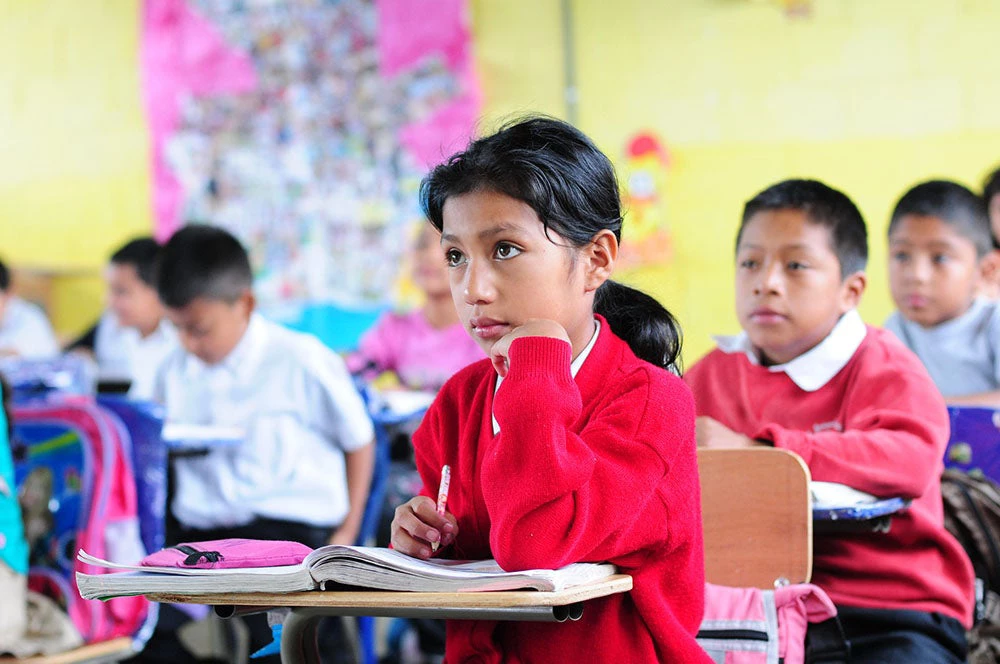
On a previous blog, we highlighted the importance of monitoring learning for all through the lens of a minimum proficiency level, which focuses on those students at the bottom of the learning distribution – as countries have agreed in the Sustainable Development Goals. We examined how proficiency has changed over time, showing that this measure is sensitive to changes in the learning distribution and that increases in learning inequality have always been accompanied by the worsening of educational outcomes.
What comes to mind when you think about inequality in educational outcomes? Most people immediately picture disparities by sex, socio-economic status, or race and ethnicity. These are examples of horizontal inequality: inequality between different socially and culturally formed groups. Unfortunately, horizontal inequality remains widespread. In Afghanistan, twice as many girls as boys aged 9-12 have never been to school. In Brazil, youth from the top income quintile are 55 percentage points more likely to complete secondary education than youth in the bottom quintile. And in the United States, Asian students are almost twice as likely to graduate from college than Black students.
There is also inequality within groups, known as vertical inequality. Differentiating between these two types of inequalities – between groups (horizontal inequality) and within groups (vertical inequality) – is valuable for policy design, since the tools and approaches required to deal with each are quite different. Much has been written regarding inequalities in access; in this blog, we focus our attention on learning inequalities.
Inequality between groups
The interactive dashboard below contains data from 109 countries over 16 rounds of international learning assessments since 2000, with observations for over 6 million students. Choose a country, assessment, subject, and breakdown – by sex, urban/rural, or socio-economic status (SES) quintile – to see how the distributions of student scores across groups differ. Besides the distribution plots, a table reports the main summary statistics of these groups: the mean, the standard deviation of scores (SD), and the proficiency level used to monitor the SDG 4.1.1 (or any share of students below a proficiency threshold chosen in our interactive dataviz).
Let’s focus on the share of students below minimum proficiency. It is customary to measure inequality by reporting the gap between groups. But it is essential to look at the overall system performance, not just its inequality: equal opportunity in a poor-performing educational system does not suffice to deliver learning for all. For example:
- Senegal and Canada had the same SES gap in the latest PISA-D/PISA results: students from the top SES quintile were 15 percentage points more likely to achieve minimum reading proficiency than students in the bottom quintile. But the overall levels were dramatically different: in Senegal, 91% of students were below the minimum proficiency, while in Canada, only 14% were.
- Peru had the largest SES gap in reading in the last PISA round, at 57 percentage points. Despite the high inequality across groups, levels are not low. In fact, the affluent Peruvian achieve learning outcomes superior to the average student in Luxembourg.
Figure 1- Distribution of test scores by groups within a country
Inequality within groups
These differences across groups – sex, urban/rural, and SES quintiles – are only a small part of the story. Jointly, they account for 13% of the overall inequality of scores within a country (with inequality across SES quintiles being the single most relevant of the three). Without getting too much into the weeds, we arrive at this number by calculating inequality indices of the Generalized Entropy class. What is special about this class of inequality measures is that they are subgroup consistent and additively decomposable. That is, they allow to parcel out the amount of inequality between and across groups.
You may notice that the groups mentioned above fail to capture differences in school resources and regional disparities. So let’s consider each school participating in the assessment as a group. Now 34% of the inequality is between schools and 66% within schools.
Even when we combine the two approaches, by considering subgroups with all possible combinations of schools, urban/rural, students’ sex, and SES quintiles, we find that only half of the inequality happens across these subgroups. Of course, the exact amount fluctuates by country subject assessment and year. But the overarching conclusion is stable over time and across assessments (and you can explore it in our data visualization): half of the inequality is between students in the same schools with the same sex and socio-economic status quintile.
Figure 2- Between- and within-group inequality decompositions
Why does it matter, and what can we do about it?
These findings are both sobering and encouraging. Realizing that the usual pathways in the quest to tackle education inequality – equalizing learning across groups – can only take us half-way towards this goal is sobering. But it is encouraging to find so much variation in learning for similar students: it means a lot of progress can be made by bringing all students in a group to the level of its top performers.
This exercise of decomposing inequality in international learning assessments shows the importance of monitoring both horizontal and vertical learning inequality, or inequalities between and within groups. Our within-group inequality is a measure of what cannot be attributed to students’ observable characteristics, such as their sex, socio-economic status, and the school they attend. What remains unobservable is complex: educators and psychologists have developed measures to capture and explain learning differences across students, but scaling up these measures in a comparable way across countries remains a challenge.
Going forward, it is essential to be deliberate and intentional on what we measure and how we measure:
- Chose measures that are sensitive to changes in inequality: The results above highlight that inequality within groups (vertical inequality) is significant, especially among the most deprived students. Thus, it is crucial to complement the standard measures of learning performance with inequality-sensitive indicators. For a discussion on measures that focus on the students below the minimum proficiency and are distributional-sensitive, please see this paper presented at the latest SDG Technical Cooperation Group meeting.
- Use differentiated instruction to target vertical inequality: Classroom instruction that is engaging and aligned to children’s learning levels, such as Teaching at the Right Level (TaRL) or structured lesson plans, prioritizes all children mastering foundational skills. These approaches were highlighted as some of the smart buys in education, and for a deeper discussions on the aspects that have made these approaches successful check the ALIGNS principles around setting clear learning goals, instructional coherence, teacher support and contextual salience.
- Identify units from which valuable lessons can be extracted: Monitoring horizontal and vertical inequality can be a powerful strategy to customize policy recommendations and to identify positive deviants. Context matters: an intervention that improves learning in a country with low inequality may not be equally effective in a country with high inequality. And within a country or district, identifying the schools with the lowest vertical inequalities can shed light on effective new strategies to get all children learning.
Tackling inequality in education calls for careful measurement and the use of measures sensitive to inequality changes. Efforts to equalize learning across groups are essential but not sufficient. We must also scale programs and interventions that tackle inequality of similar students within schools and demographic groups. We have the tools for this, and we owe it to our children.



Join the Conversation